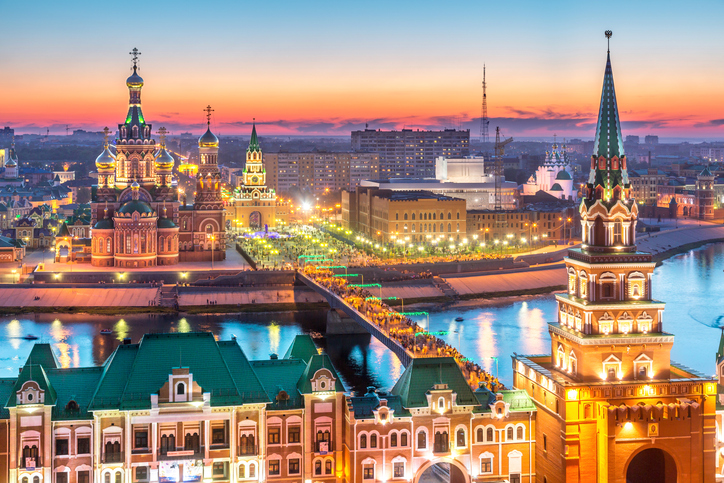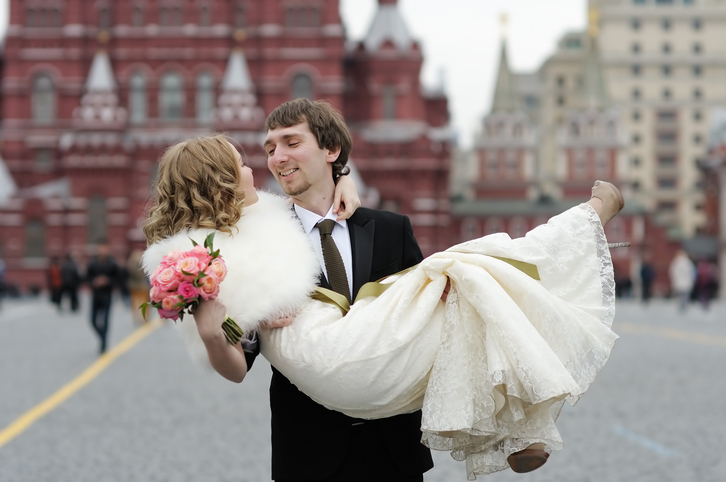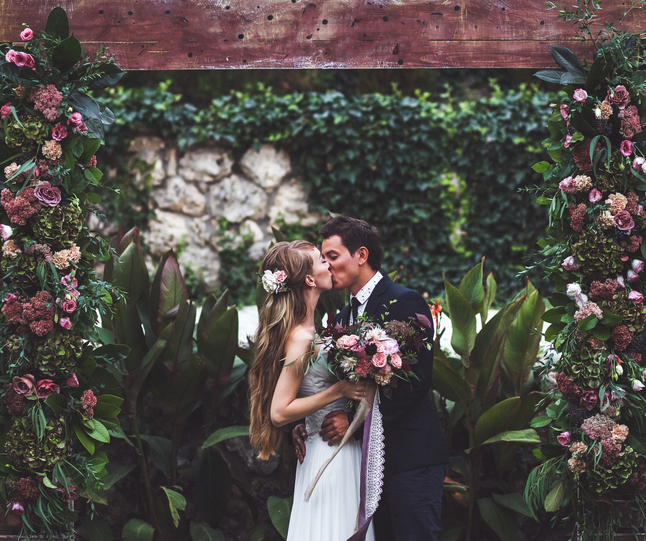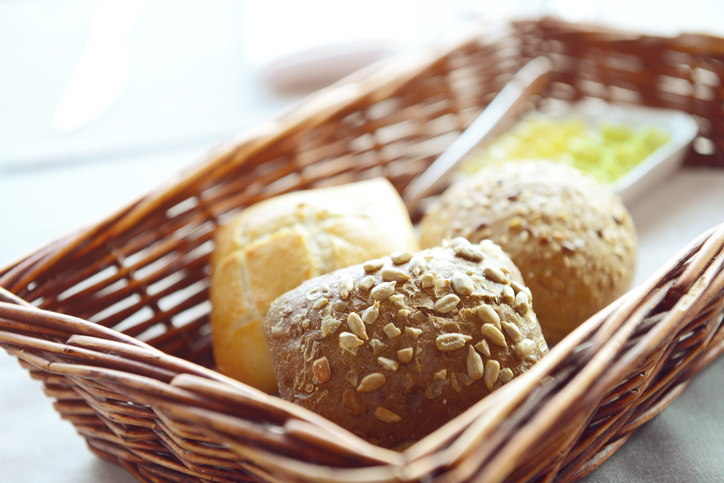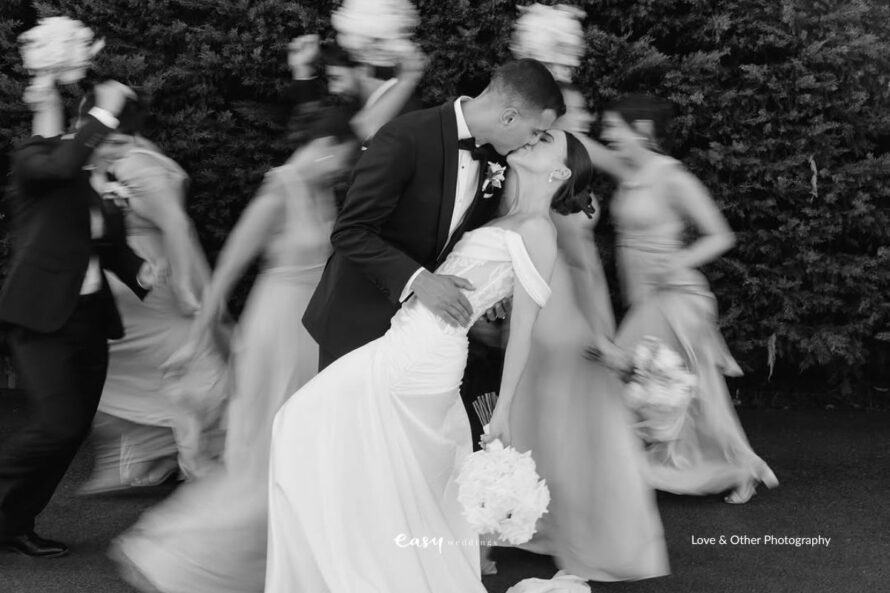From kidnapping and obstacle courses to literally being a royalty during the ceremony, there are so many amazing wedding traditions to be found at Russian weddings. Check out these 15 amazing and unique Russian wedding traditions:
The ransom
While in some countries, a very real (and often expensive) dowry needs to be paid before a wedding. In Russia, the bride’s ransom is more of a fun tradition.
The bride’s parents “steal” her away and hide her before the ceremony until her partner completes a series of challenges set up by the bridesmaids that are designed to show the strength of his love and, ultimately, embarrass him.
If a task cannot be completed, a payment of either real cash, chocolates, or flowers must be made to the bridesmaids as compensation.
Other versions of the ransom quest include dressing up a male relative of the bride in wedding attire and refusing to hand over the real one until a payment has been made, or presenting the fiancé with a napkin covered in the lipstick prints of the bridal party. If the fiancé cannot identify the bride’s print correctly, he is also up for a payment.
The ceremony…
Russian weddings can take many forms, but a marriage is only legally recognised once you have made a trip to the registration office, the Zapis Aktov Grazhdanskogo Sostoyaniya.
Couples can choose to have a small civil marriage registration affair, where the couple literally sign papers in an office and head off to party, or they can accompany this with a civil ceremony, which lasts for 15 to 30 minutes, or go the whole hog and have the longer traditional ceremony as well.
Some couples choose to sneak in this formality before their wedding day to leave more time for the fun stuff.
Betrothal
The betrothal is the first part of a traditional Russian Orthodox ceremony. This is where the couple stands at the entrance to the church and is blessed by the priest.
They receive lit candles, that they then hold onto throughout the ceremony, which includes a prayer and scripture readings.
Crowning
Because a wedding is considered one of the seven sacraments for Russian Orthodox followers, there is more importance in placing crowns onto the heads of the couple than there is in exchanging wedding rings.
The crowning is the second part of the traditional ceremony and is where the couple stand on a piece of rose-coloured cloth and the priest places the crowns onto their heads. These can sometimes be held in place by relatives or friends.
The couple shares a cup of wine and follow the priest three times around the lectern to symbolise their journey into married life.
Traditionally, the crowns would be worn for eight days after the ceremony, but they are now taken off after the priest announces the union and says the benediction.
Smashing good time
Once the couple is announced as newlyweds, their parents offer them a crystal glass each. They then muster all of their strength to shatter them into as many shards as possible, as each piece signifies a year of happy marriage.
Balloon?
It is also traditional for the bride to release a balloon with her maiden name written on it, as she begins her new life with her new name.
Witnesses
It was once a legal requirement for Russian weddings to include two witnesses at the official registration of the marriage. While this is no longer necessary, couples will still choose two witnesses for their wedding day, who will get to wear a special sash to identify their position.
These witnesses are often what we would call the maid of honour and the best man.
The grand road trip
Once the official registration has been carried out, the newlyweds set off on a well-worn path to visit landmarks to get photos and carry out traditional things at each site.
Russian newlyweds could do these tasks alone but often travel around with a small group of friends and family.
Couples who marry in St Petersburg will often do several of the following things:
- Head to Senate Square to get photos with the eternal flame of the heroes of World War II, the Bronze Horseman statue and the monument to Peter the Great.
- Visit Peter Vassilevsky Island to pet the 4000-year-old Egyptian statues and stone griffons for good luck.
- Pose for photos with their hands inside the Rostrum Column to symbolise their new bond of marriage.
- If they haven’t yet smashed their crystal glasses, they can head to the Peter and Paul Cathedral and do so against the concrete sphere near the fountains.
- Go to the New Hermitage Portico and rub the toes of the marble Atlanti statues for good luck.
- Visit any other religiously meaningful structures for photos.
Road train
The road trip posse will need transportation to get them around to all of these landmarks, so the couple will arrange for limousines or a series of cars decked out in gold rings and flowers to take everyone around in.
The second round
Because the road trip segment of the wedding day is so time-consuming, most Russian weddings last two days.
As day two rolls around, the couple is no longer in their formal wedding attire but still dress smartly. This is when the reception kicks off.
Let the games begin
There is lots of eating, drinking, and being merry. And because traditionally, Russian couples marry earlier (before they are 24 years old), there are a lot of fun games that are played during the reception.
These include pitting the newlyweds against one another to see who can put nappies onto or dress a doll the fastest, allowing guests to vote for the gender of their first baby by placing money onto either a pink or blue plate, and having a fake couple show up, sending the guests into a flurry to find the real couple, who will be hiding somewhere.
You stay, you pay
If you are a guest at a Russian wedding reception, you will need to be prepared to pay for the privilege of a glass, plate, and cutlery to be able to fully enjoy the food and drink on offer.
The reason guests have to pay for these items is to help the newlyweds to get an extra boost to their coffers as they start their new lives together.
Cleaning the floor
As guests arrive at the reception, they drop money (either real or fake) onto the floor and it is the bride’s responsibility to clean it all up.
Gorko!
Wedding toasts are often wrapped up with a shout of “Gorko!” which means bitter. This is a signal for the newlyweds to kiss. Tradition says the sweetness of their kiss will enhance the ‘bitter’ drinks.
Guests will also count aloud how many seconds the kiss lasts for, and this is said to show the strength of their love for one another.
Just so that the newlyweds aren’t having all the fun, the guests then have to finish off their drinks straight away.
Bride-napping
As if being ‘captured’ before the ceremony isn’t enough, reception guests can also choose to bride-nap her during celebrations, forcing her new spouse to cough up a ransom in order to get her back.
Take a bite
Before the newlyweds head off from their reception, they take a bit of a traditional bread loaf that is heavy on salt. The superstition dictates that the person who takes the biggest bite will become the head of their future household.
